Plastic Surgery Clinic in korea
Korean plastic surgery stands at the forefront of Asia’s beauty industry, recording the highest per-capita rate of procedures worldwide and forging an approach that emphasizes enhancement and prevention through subtle, natural results that harmonise with existing Asian facial features. While many practitioners rely on cartilage autografts, Korean rhinoplasty often favours silicone allografts to refine the bridge, complemented by operations like eyelid surgery for soft crease formation, face and jawline contouring that slenderises the silhouette, breast augmentation and body-sculpting liposuction, plus Botox, fillers and skin rejuvenation to slow any future ageing.
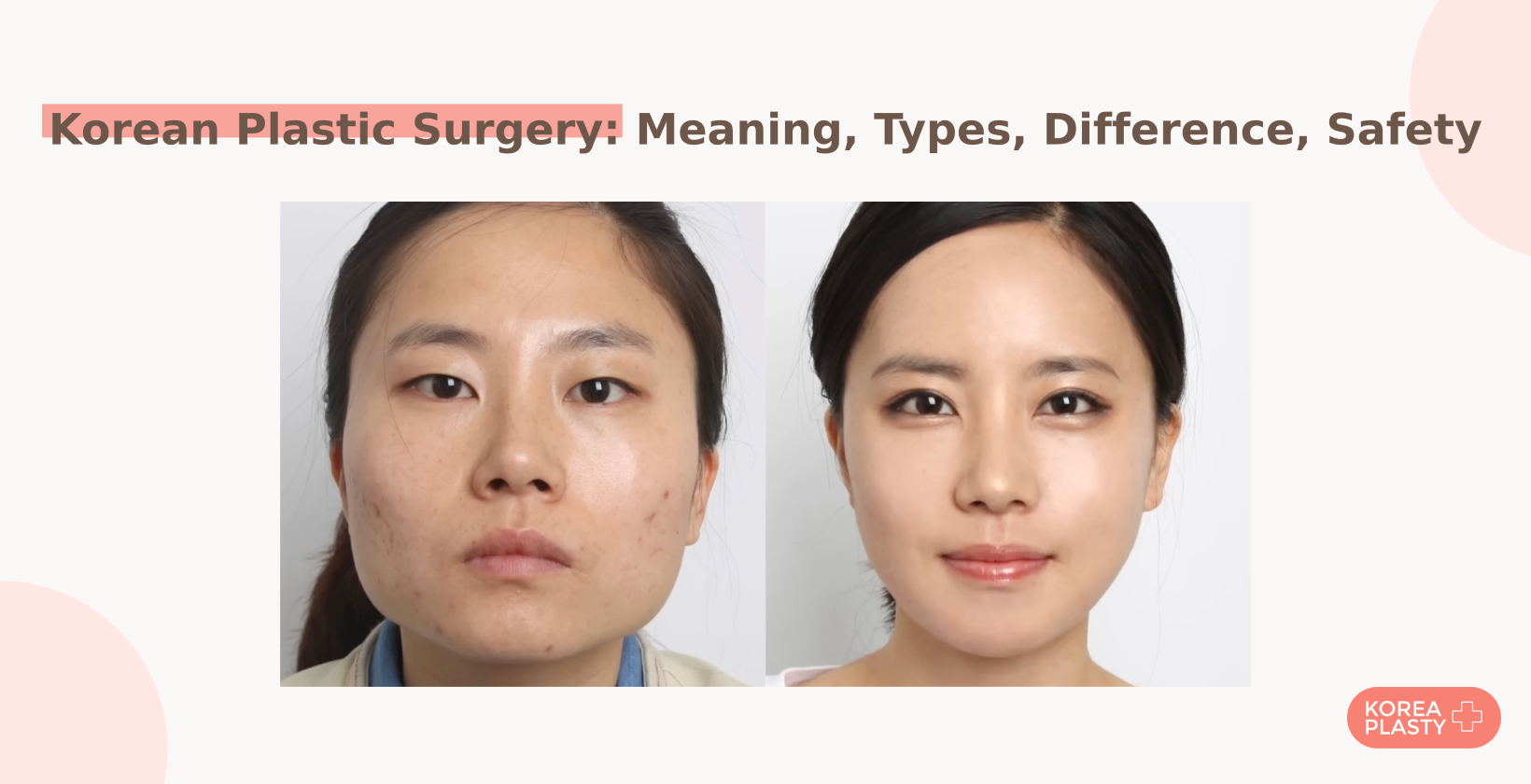
All interventions are performed by well-trained, board-certified surgeons within clinics that mandate rigorous patient screening and a multi-step post-care programme including compression dressings, lymphatic massage, laser therapy and follow-up consultations to minimise infection, scarring and downtime while maximising symmetrical, youthful outcomes that echo East-Asian aesthetic ideals.
About
What is Korean plastic surgery?
Korean plastic surgery is a cultural phenomenon driven by societal standards of beauty. In South Korea, external appearance is viewed as an important factor for relationships and achievements; prevalent lookism has caused plastic surgery to grow from a subculture into mainstream culture that penetrates deeply into society. Korean society encourages achieving physical perfection through surgical enhancements.
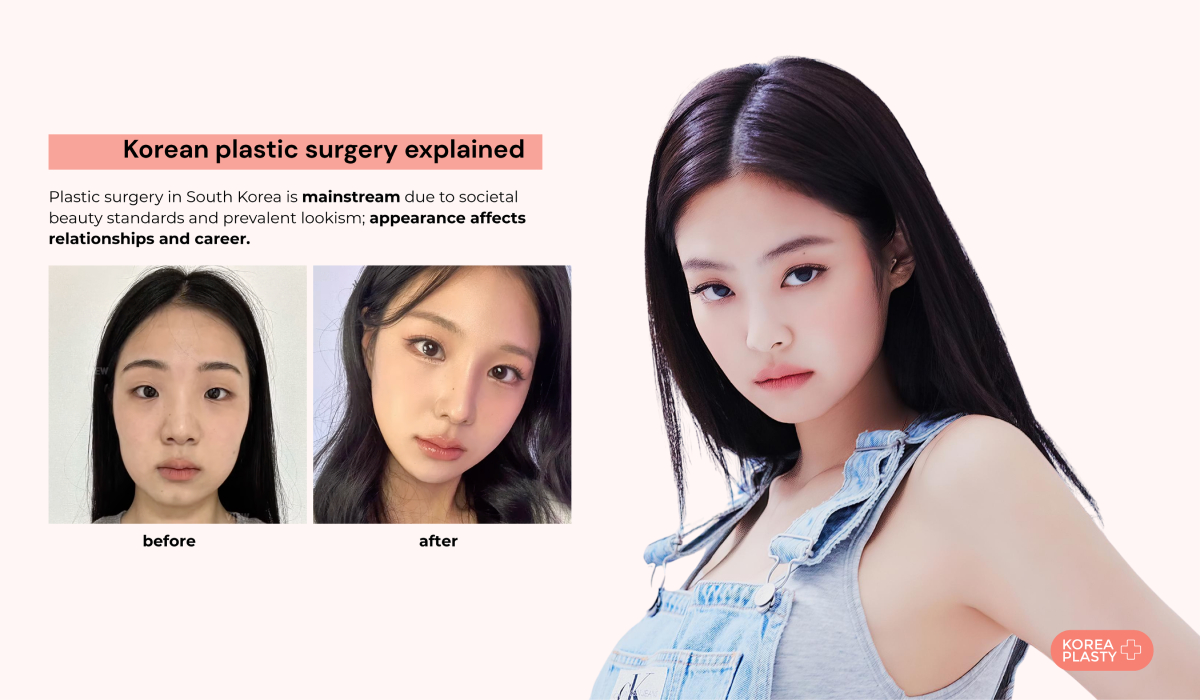
Korean plastic surgery is known as the plastic surgery capital of the world and has built a world-class reputation. It leads globally with the highest rate of cosmetic procedures per capita. Korean plastic surgery is known for cutting-edge techniques, highly skilled surgeons, and natural-looking results. Korean plastic surgeons perform significantly more procedures than average Western surgeons: a Korean plastic surgeon performs more procedures in one month than many Western surgeons do in a year, and Korean surgeons have spent decades perfecting techniques specifically for Asian features, creating results that look natural, not Western.
Korean plastic surgery focuses on facial aesthetics, which represent 77.5% of total surgical procedures, including facial contouring, double eyelid surgery, rhinoplasty, V-line jaw reshaping, zygoma and cheekbone reduction, and septoaponeurosis junctional thickening for double-lid blepharoplasties. Korean plastic surgery follows the golden ratio approach to refine and balance facial proportions, aiming to create a slimmer, more feminine jawline and a V-contoured face. Korean plastic surgery also offers body modeling procedures like breast augmentation, liposuction, and calf remodeling and reduction. Non-surgical options include Botox, fillers, thread lifts, laser skin tightening, and regenerative medicine.
Korean plastic surgery clinics are located in the Gangnam/Apgujeong area and provide modern state-of-the-art facilities that meet US Federal standards, with single-person hospital rooms offering hotel-grade amenities. Clinics invest in the latest medical technology, including AI-powered consultations and virtual reality planning, and offer all-inclusive medical tourism packages with transfers and accommodation for foreign patients. Korean plastic surgery clinics attract patients from over 100 countries, with 47,500 foreigners visiting Korean plastic surgery clinics each year and 190,000 foreign patients visiting in the past four years.
What is the history of plastic surgery in Korea?
Plastic surgery in Korea began in the mid-1950s when American doctors brought reconstructive techniques during the Korean War; Ralph Millard, stationed in the southern part, performed double-eyelid procedures, and Yoo Jae-Deok began operating in 1961. After domestic specialists studied overseas and introduced the discipline to universities, plastic surgery was officially recognized as a subspecialty in South Korea in 1973; Jae-Duk Lew is credited as the first to introduce it, while Dr. Se-Min Baek later established craniofacial and two-jaw reconstructive surgery. The 1980s marked a pivotal decade: private clinics providing cosmetic services outgrew reconstructive programs after healthcare reforms nationalized the system, and the Korean Society of Aesthetic Plastic Surgeons was established in 1985, accelerating aesthetic techniques.
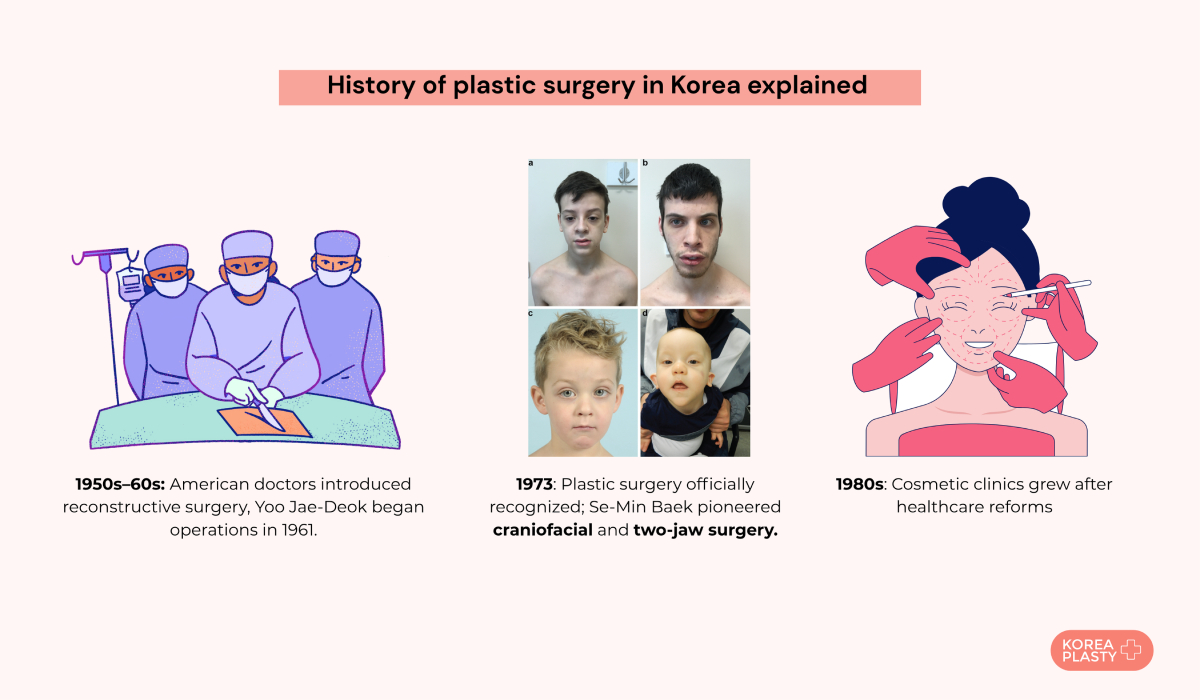
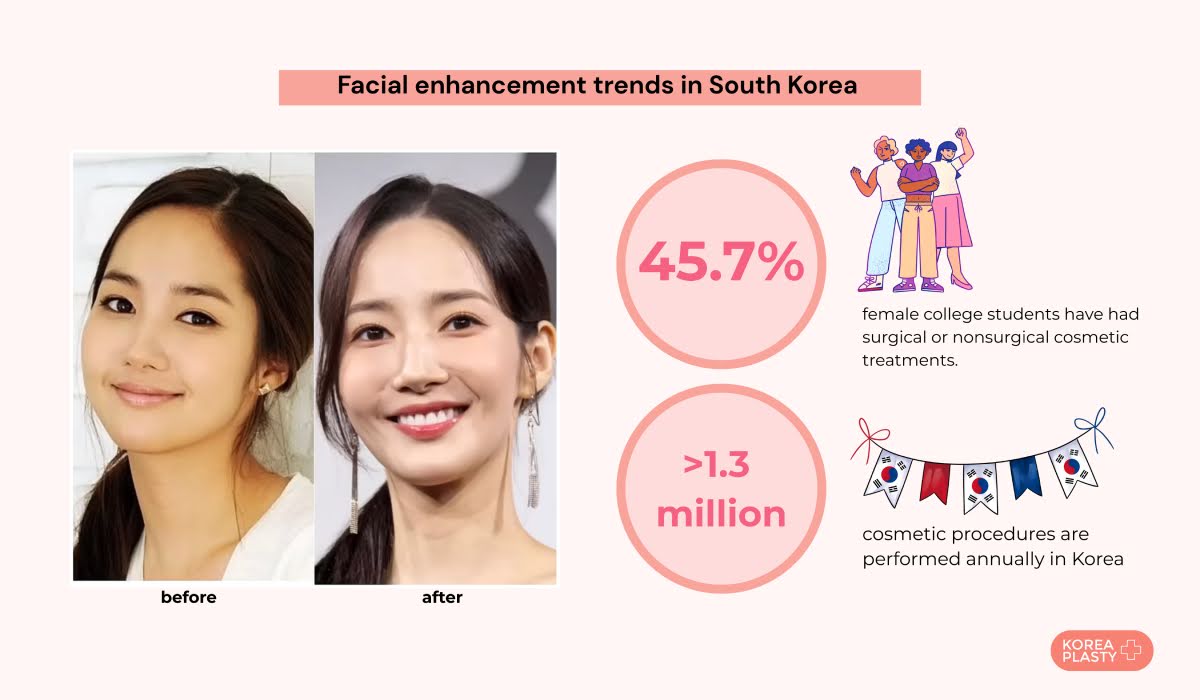
Is face plastic surgery popular in Korea?
Facial plastic surgery is popular in Korea among both men and women. Facial aesthetics account for 77.5% of total surgical procedures in South Korea. A 2018 survey of Korean female college students showed that 45.7% had already experienced a surgical or nonsurgical aesthetic procedure, while 86% of general respondents in a 2015 Gallup consumer report regarded looks as an important part of daily living.
One in five Korean women have undergone plastic surgery, and between 20 percent and 30 percent of Korean women have had such surgery according to researchers Ruth Holliday and Joanna Elfving-Hwang. Men make up fifteen percent of the plastic surgery market. Over 1.3 million cosmetic procedures are performed in Korea annually, giving the country the highest rate of cosmetic procedures per capita globally-13.5 per 1,000 people, more than twice the rate of the United States and Brazil.
Lookism has transformed plastic surgery from subculture to mainstream culture in South Korea, and the popularity is reinforced by K-pop idols and K-beauty trends. Foreign patients make up 40 to 50 percent of all plastic surgeries performed in South Korea, sustaining medical tourism; in 2018 alone, 464,452 patients visited the country for cosmetic surgery, a 16.7 percent increase from 2017.
What is the most common plastic surgery in Korea?
Double eyelid surgery is hands-down the most requested Korean face surgery procedure. Eyelid surgery accounts for 31.0% of total surgical procedures, making it the single largest category. Double eyelid surgery creates a crease in the eyelid, giving the appearance of larger, rounder eyes. Non-incisional and incisional techniques are offered; both aim to create a crease that enlarges the apparent size of the eye.
Rhinoplasty is the second most requested procedure, representing 29.6% of total surgical procedures. Rhinoplasty reshapes, resizes, and lifts the nose, creating a more balanced facial aesthetic. Men’s rhinoplasty is now common in Korea, and revision rhinoplasty is available for secondary corrections. Together, eyelid surgery and rhinoplasty constitute 60.6% of all surgical operations, confirming that facial aesthetics drive 77.5% of total surgical procedures.
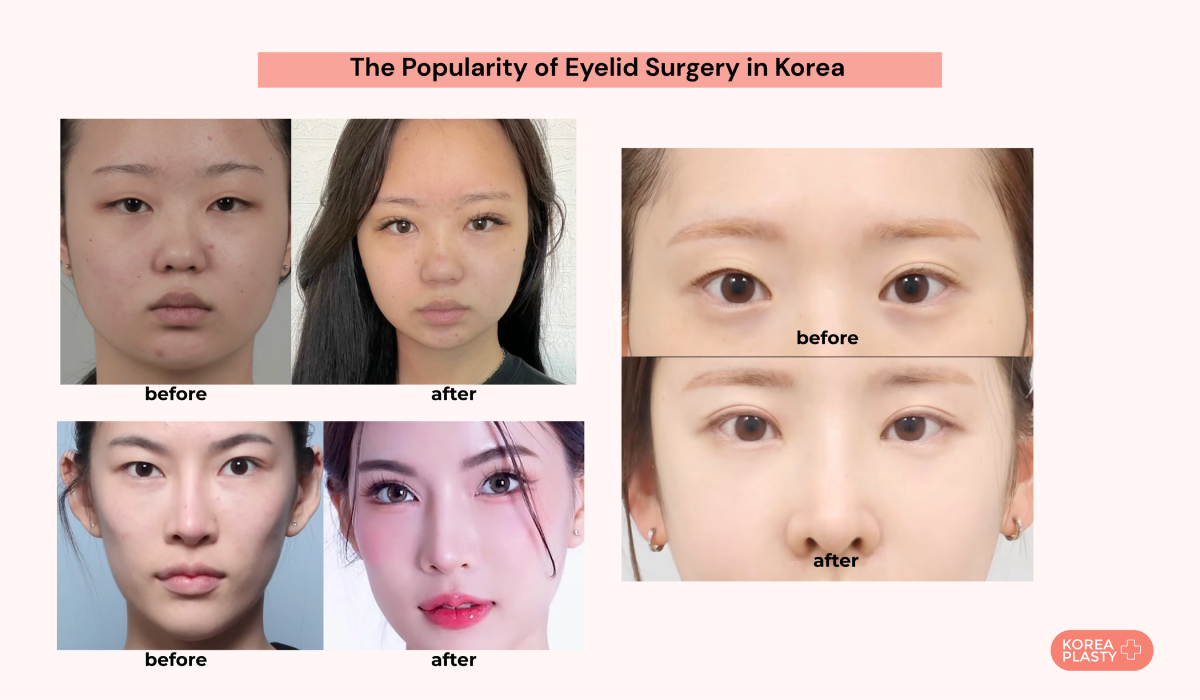
Is plastic surgery for eyes popular in Korea?
Yes; eye surgery is the single most popular cosmetic field in Korea. Double eyelid surgery, also called blepharoplasty, has become one of the most sought-after cosmetic procedures. Clinics offering blepharoplasty proliferated in the 1990s, and today roughly 200,000 people undergo the operation every year. Medical tourism agencies routinely advertise the service, so the technique is popular not just in South Korea but in Taiwan and India as well.
Double eyelid carries little stigma among young adults; it is a common part of self-improvement and is equally offered for men. Surgeons provide upper blepharoplasty to create a clear and strong eyelid line, making the eye look larger and brighter, along with lower blepharoplasty that targets under-eye bags and dark circles. Satellite techniques such as ptosis correction, inner corner eye surgery, and under-eye fat reposition or removal further refine shape. Because a neatly defined lid makes it easy to try popular makeup techniques, K-pop idols and influencers frequently cite the procedure, reinforcing its everyday acceptance.
The range of techniques available keeps Korean double eyelid surgery in demand. Made Young and similar clinics frame upper and lower blepharoplasty as procedures that enhance both aesthetics and function of eyes. International patients flock to Seoul, and statistics from 2024 show plastic surgery occupied 16.8 percent of all medical procedures amid tourists, cementing the country’s status as an eye-surgery hub.
What age can you get plastic surgery in Korea?
By law, you have to be 19 years old to undergo plastic surgery in Korea without parental consent; under 19, minors need parental consent for plastic surgery until they turn 18.
Every third woman between the ages 19-29 has had some kind of cosmetic or plastic surgery procedure done in Seoul. Patients on the younger end typically wait until about 18 years of age before committing to any cosmetic procedure, because the minimum age limit is 18 in South Korea and younger patients still undergo procedures with parental consent and proper evaluation by a surgeon.
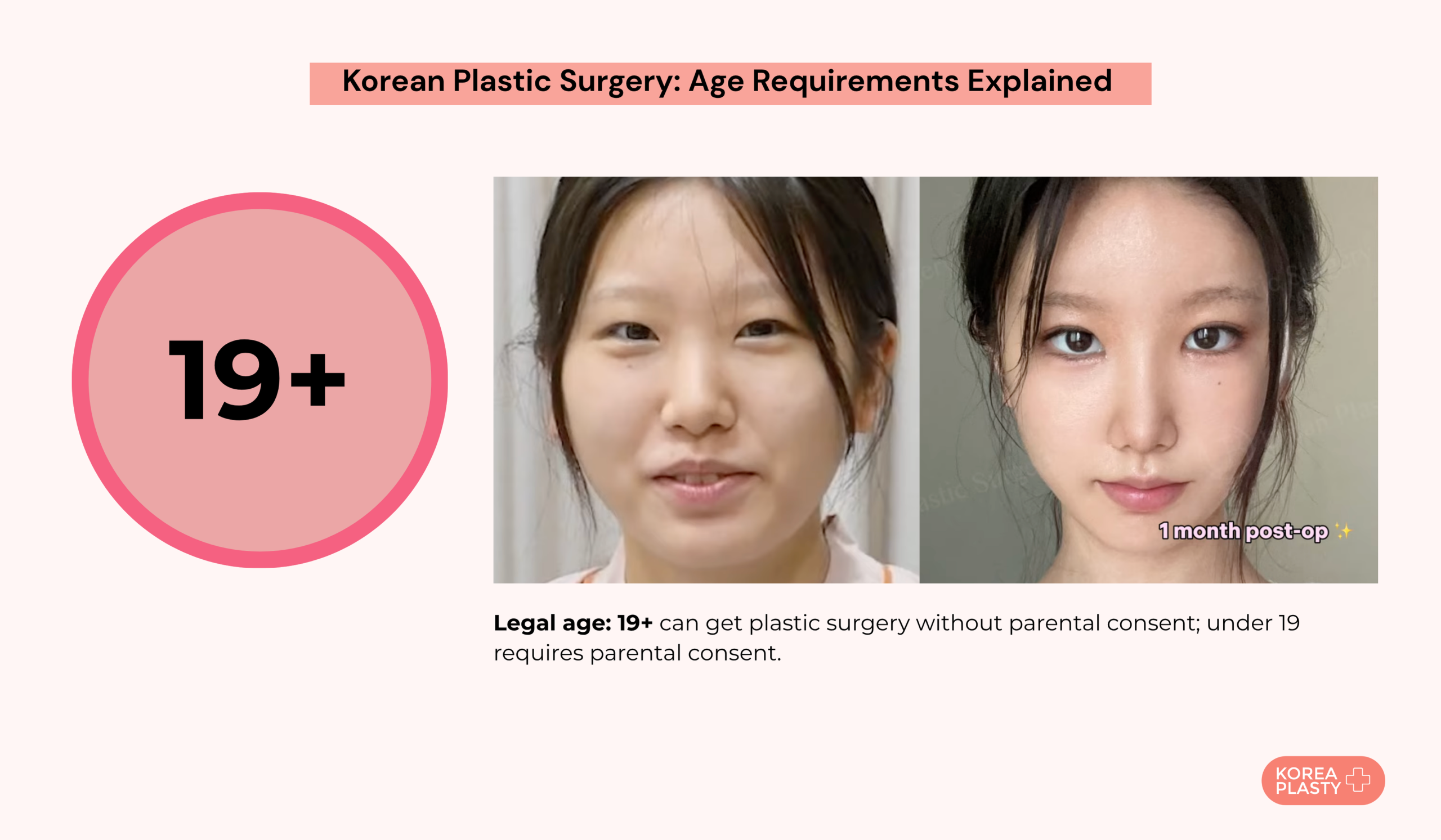
Is plastic surgery in Korea vs Thailand better?
The comparison of plastic surgery in Korea vs Thailand is given in the table below.
| Parameter | South Korea | Thailand |
| Market Focus | Subtle changes | Dramatic transformations |
| Expertise | Specialized expertise | Comprehensive approach |
| Procedures | Precision | Versatility |
| Cost Comparison to US | 30-50% savings | 30-50% savings |
| Popular Procedures | Not specified | Body contouring, breast augmentations, gender affirmation surgeries, facelifts |
| Price Range (USD) | Not specified | $543 – $5,932 |
| Technology/Innovations | Cutting-edge technology, 3D imaging, simulation | Not specified |
| Medical Tourism | Not specified | Integrated medical tourism experience |
| International Attention | Not specified | Received international attention |
| Procedure Speed | Faster | Not specified |
The answer depends on the look a patient wants and the part of the body that will be treated. South Korea leads with innovations like 3D imaging and simulation, and its clinics are known for speed and millimetre-level planning; consultations are short, incisions are tiny, and the same surgeon finishes a double-eyelid or rhinoplasty in under an hour. Because volume is high and overhead is lower than in the United States, procedures in South Korea are competitively priced compared with other countries, yet the result is usually a subtle change that preserves ethnic identity and looks natural on East Asian bone structure.
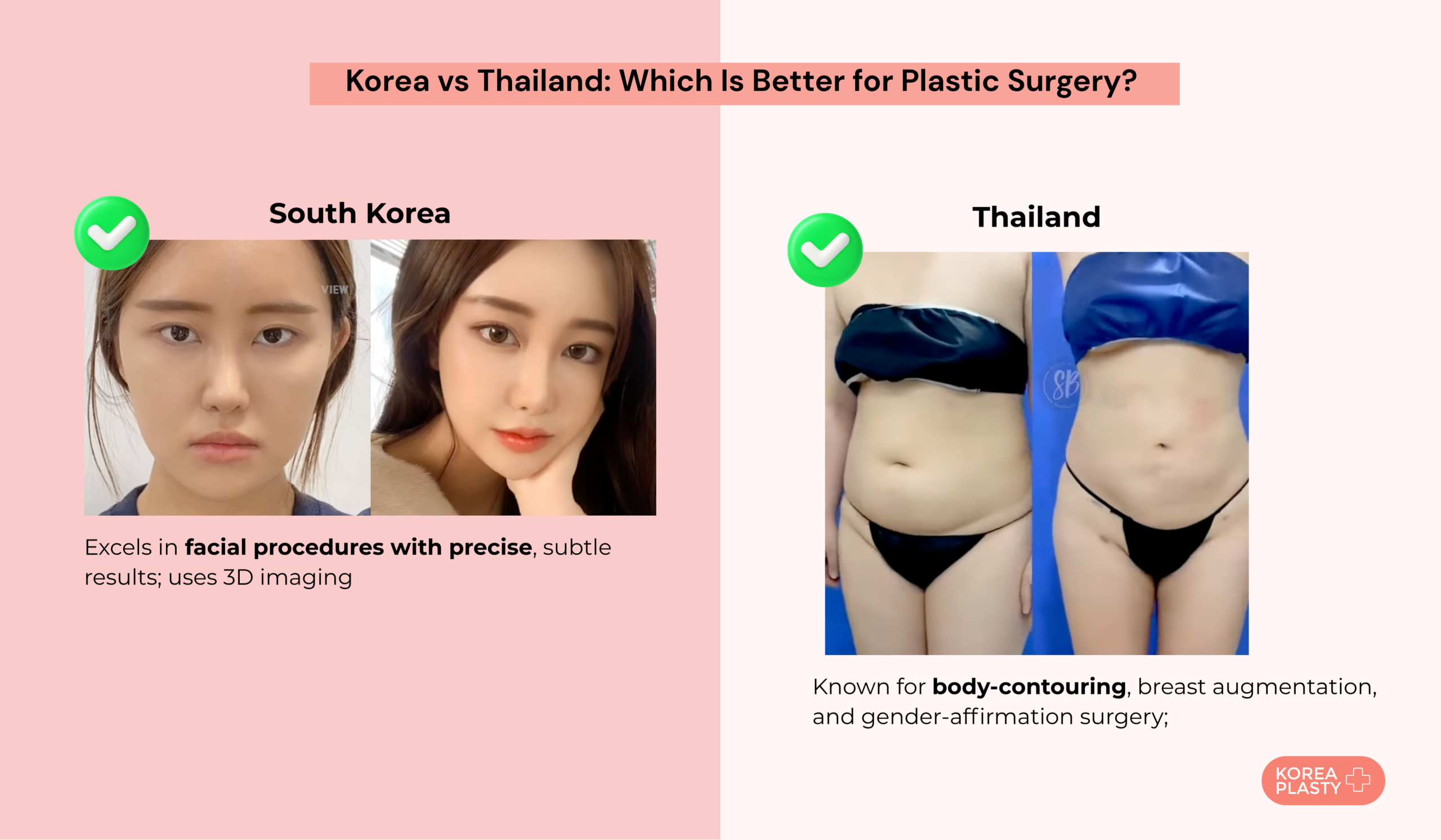
Thailand’s plastic surgery industry is characterized by competitive pricing and versatile expertise. Thai plastic surgeons are celebrated for their expertise in body-contouring procedures, breast augmentations, and gender-affirmation surgeries; the country attracts patients from Indonesia and tourists from Western or Middle Eastern countries who combine a two-week holiday with an operation. Thailand offers plastic-surgery prices ranging from US$543 to US$5,932, and the medical-tourism experience bundles airport transfer, hotel-style wards, and post-op nursing at a nightly rate that is still lower than a Seoul clinic alone. Whereas South Korea’s approach aims for subtle changes, Thailand’s approach often produces more dramatic results-larger implants, fuller lipofilling, and sharper profile angles-suited to patients who want an obvious transformation rather than a refine-ment.
Safety records in both destinations are solid when elite hospitals are chosen. South Korea’s reputation is unparalleled for facial work, but Thailand’s JCI-accredited centres perform triple the number of body cases, so complication rates for augmentations and lifts are statistically lower there. In short, Korea is better for restrained facial refinement, Thailand is better for bold body reshaping; neither is universally superior, and the wiser choice is the one that matches the patient’s aesthetic goal and budget.
Should I go to Korea for plastic surgery?
Seoul offers a variety of plastic surgeries at affordable prices, and South Korea has a well-established medical tourism industry that caters to international patients. Each year, 114,000 foreign patients visit Korea for cosmetic transformations, and a record-breaking 1.17 million overseas patients visited Korea last year. Plastic surgery accounted for 11.4 percent of overseas patients.
Korea offers regulated quality and transparent costs for medical tourism patients. Many clinics provide English-speaking staff and bilingual consultation services. Korean medical tourism agencies assist with visa assistance and travel arrangements. Korea provides a medical visa (C-3-3 Medical Tourism Visa) for medical tourists, and citizens from 114 countries are exempt from applying for a medical visa for 30-90 days.
Patients must have the appropriate visa and make travel plans in advance. They must assure their passport is valid for 6+ months. Dr. Peterson advises you to have the appropriate visa and recommends choosing only surgeons certified by the Korean Ministry of Health.
Major procedures require 2-3 weeks stay, moderate procedures require 10-14 days stay, and minor procedures require 5-7 days stay. Rhinoplasty requires 10-14 days stay, V-line jaw surgery requires 14-21 days stay, and breast augmentation requires 10-14 days stay. Patients need to plan for limited in-person follow-ups after returning home.
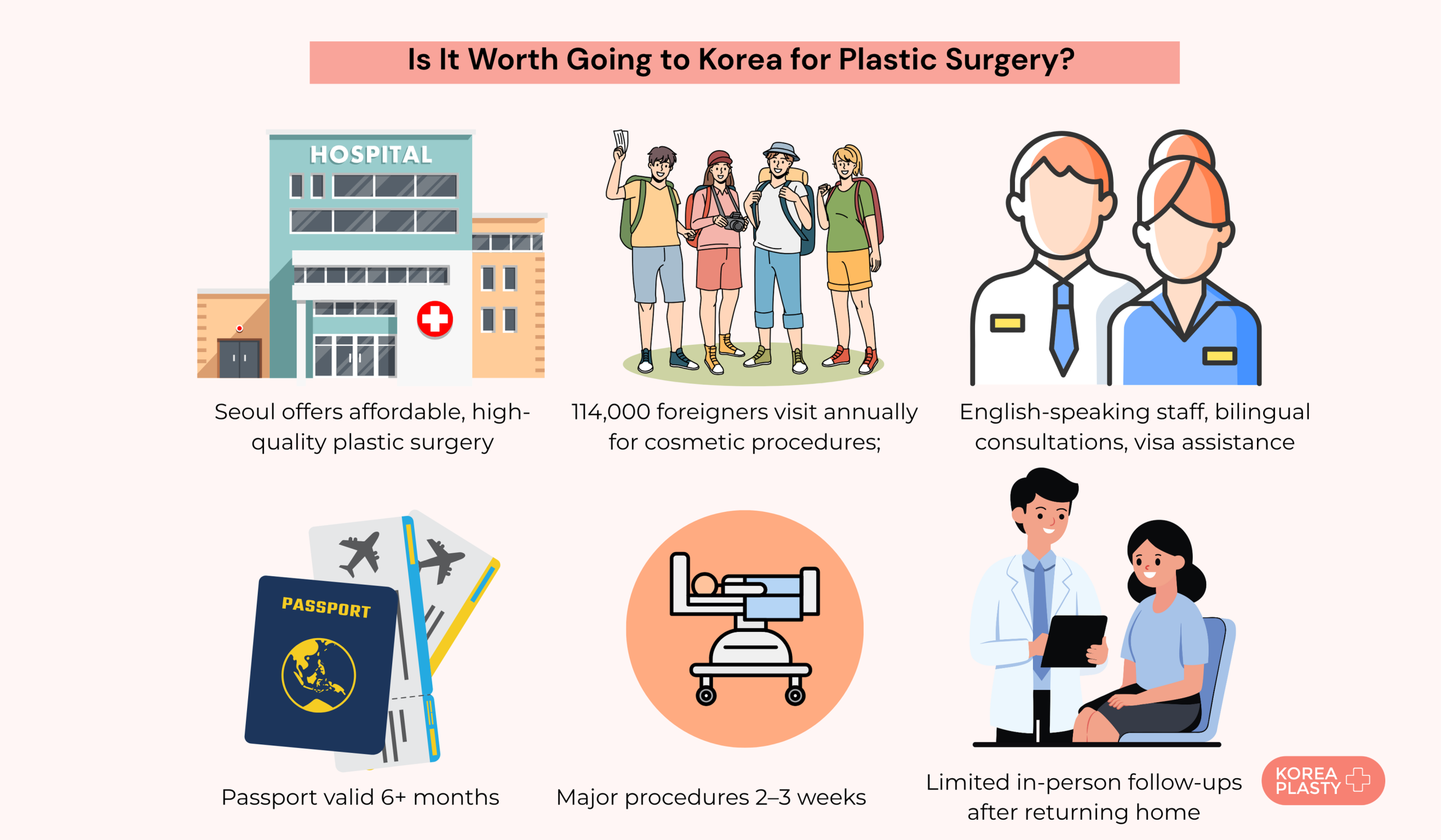
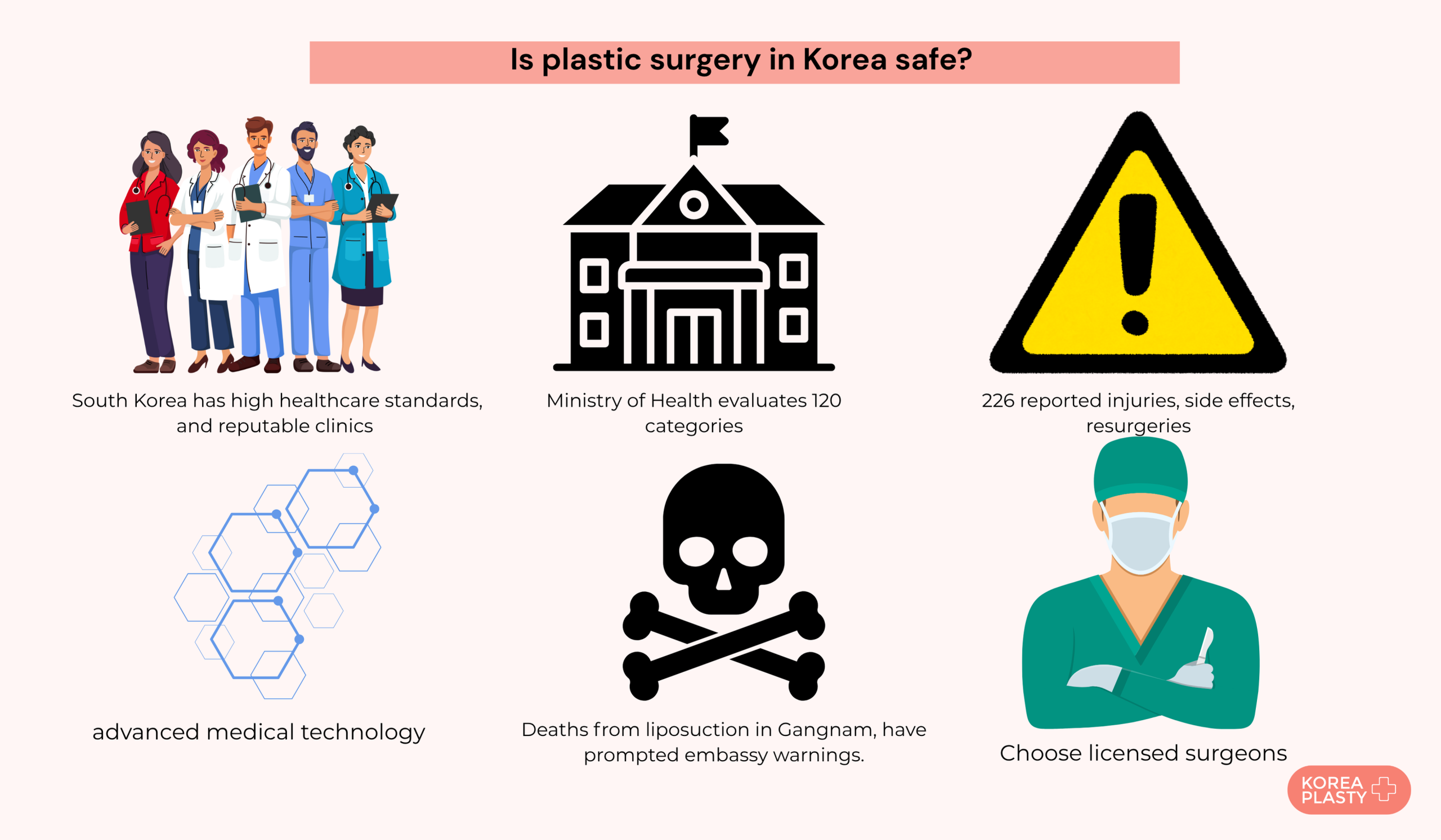
Is plastic surgery in Korea safe?
Plastic surgery in South Korea is generally safe when conducted by reputable clinics and experienced surgeons, thanks to the country’s advanced medical technology and high healthcare standards. Many clinics adhere to high safety and quality standards, and some, like JK Plastic Surgery Clinic, report zero medical accidents in 25 years since opening in 1998. The Ministry of Health and Welfare directly evaluates 120 categories-including patient safety, surgery management, infection control, and anesthesia-to select medical institutions that attract foreign patients.
However, there are risks. The Korean Consumer Agency reported 226 people injured, experiencing side effects, requiring resurgery, or who died between 2016 and 2020. Activists say weak regulations have allowed factory-like clinics to thrive where unqualified staff substitute for surgeons. Illegal ghost doctors, unlicensed practitioners, operate under the radar, putting patients at risk. A Chinese woman died shortly after receiving liposuction at a clinic in Gangnam, and similar cases, including the death of a Hong Kong heiress, have prompted warnings from China’s embassy in Seoul about risks: death and major facial changes that complicate immigration checks.
To guarantee safety, it is important to choose a reputable and licensed surgeon, as only certified specialists can officially call their practices plastic surgery clinics. Thorough research, careful planning, and clear communication maximize the chances of a successful and safe procedure.
How does Korean plastic surgery work?
Korean plastic surgery is done by well-trained and board-certified surgeons in modern, state-of-the-art facilities. They do not just fix-they optimize. Surgeons who perform 10 more procedures than global averages have spent decades perfecting personalized techniques for Asian features, creating results that look natural, not Western. Facilities use AI, stem cells, robotic assistance, and minimally invasive techniques unavailable elsewhere. Genetic testing predicts healing patterns and customizes procedures.
Consultation begins with AI algorithms that analyze facial features and predict results with 95% accuracy; patients can see their outcome before surgery with 99% accuracy. 3-D CT scanning guides surgical planning. V-line jaw reshaping shaves the jawbone and chin through a single 5 mm (0.197 inches) intraoral stab incision on each side, reducing operative time and post-operative edema. Endoscopic techniques and tiny incisions behind the ears and under the chin minimize scarring; incisions become virtually invisible over time. Rhinoplasty preserves ethnic characteristics while creating harmony with facial features; silicone allografts are preferred to cartilage autografts. Double-eyelid surgery offers 12 different techniques that enhance, not erase, ethnic features. Breast augmentation achieves a natural, youthful shape using discreet implants and minimal scarring techniques. VASER liposuction gives faster healing and smoother results. Clinics also offer combination treatments that deliver surgical-level results without going under the knife.
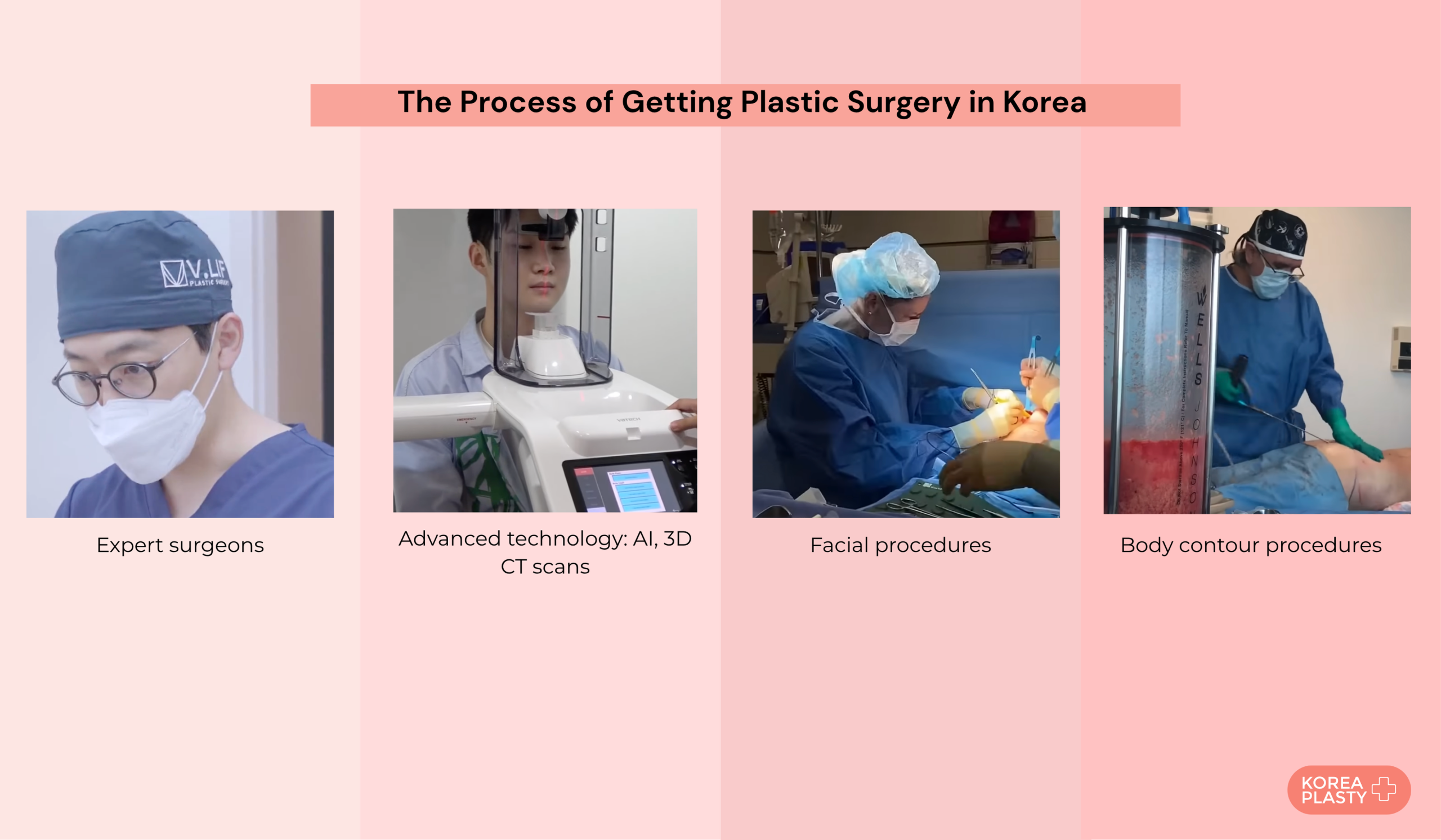
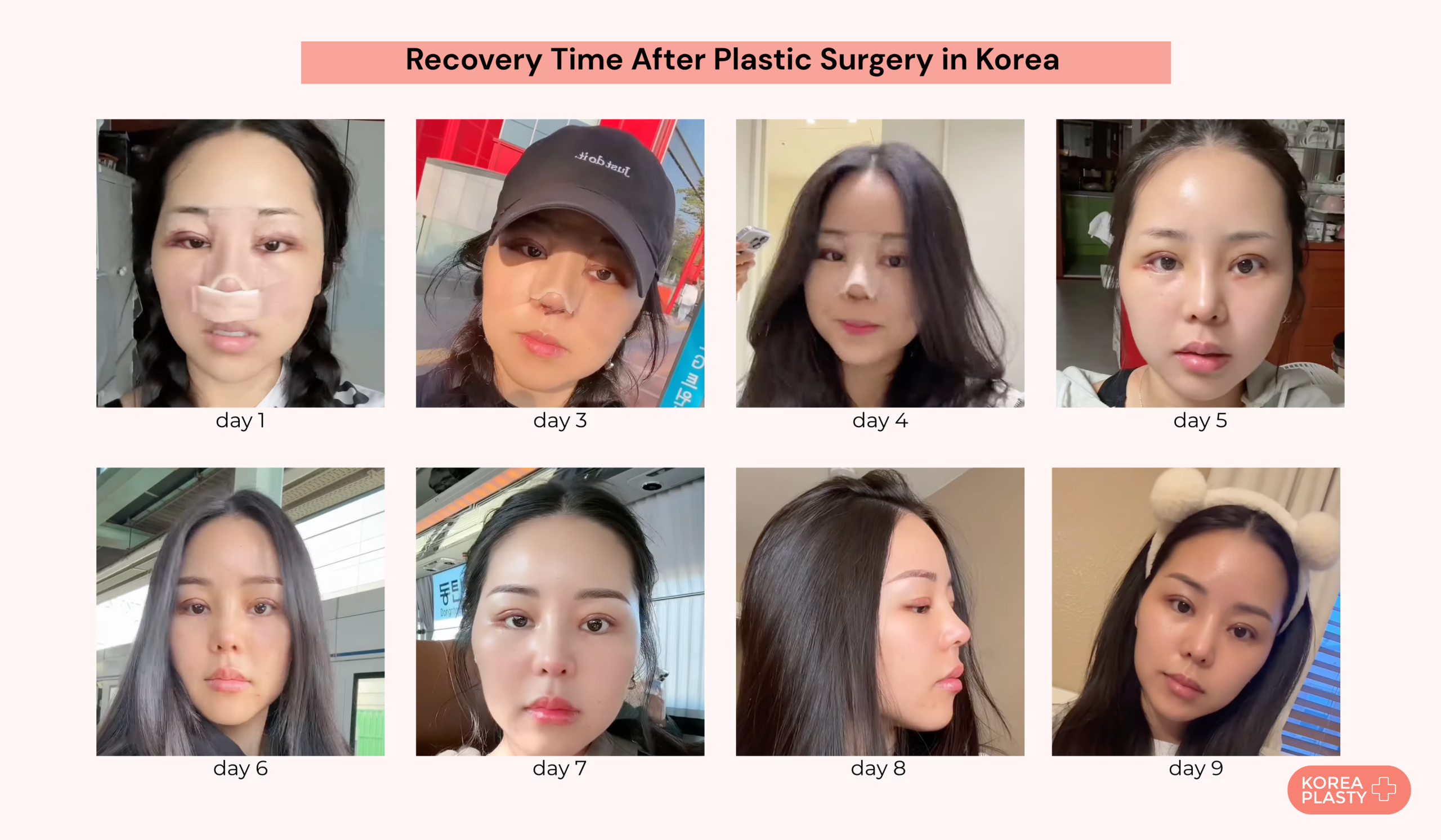
What is the recovery time for Korean plastic surgery?
Recovery time after Korean plastic surgery depends on the procedure and the individual healing process.
Double eyelid surgery (non-incision method) usually needs 1-2 weeks, while the incision method is faster at 7 days; in both cases, stitch removal occurs between 2 and 4 days and no hospitalization is required. Eye surgery in Korea generally takes 7-10 days. Korean rhinoplasty, whether primary or involving cartilage harvest, plans for 10-14 days. Revision rhinoplasty, V-line jaw, Korean chin surgery, Korean facelift or deep-plane facelift is scheduled for 14-21 days with staged suture removal around day 10-14. Korean breast augmentation and forehead reduction both plan for 10-14 days. Body liposuction and breast procedures together need 7-14 days, depending on drains and closures. Hair-transplant patients, especially those receiving FUT, allow 7-14 days for stitch removal around day 10-14.
Regardless of the operation, the first week is difficult: swelling and bruising peak at 48-72 hours and subside thereafter. Surgeons therefore advise staying in Korea for at least 7-10 days, while many recommend planning for 1-2 weeks to attend follow-up visits, receive post-operative medication and dressing changes, and secure final medical clearance for travel on day 10-14. Complicated procedures require a longer stay; skipping scheduled checks jeopardizes recovery.
Post-operative care includes avoiding strenuous exercise for about two weeks, avoiding smoking and alcohol for four weeks, and avoiding salty and spicy foods for the first week. Double-eyelid patients must refrain from wearing contact lenses for three weeks. Clinics supply relaxation aids, ice packs, and light, nutrient-rich Korean meals that help reduce swelling and support tissue repair. Patients message the clinic with photos and a symptom timeline, and services like IV therapy, LED treatments, manual lymphatic drainage, or HBOT speed healing.
How much is plastic surgery in Korea?
Plastic surgery in Korea costs 30-50% less than in Western countries, which makes Seoul a popular destination for both Asian Blepharoplasty and full facelift packages. Eyelid Surgery price average South Korea is $3,000 and Double Eyelid Surgery cost $2,000-$4,000. Rhinoplasty price range $3,000-$9,000. Facelift price average South Korea is $9,500, while premium facelifts in the United States exceed $25,000. Breast Augmentation price average South Korea $7,000. Liposuction price average South Korea is $5,500. Facial Contour KRW 3M-6M. Forehead Reduction price range $3,300-$4,500. Chin Surgery price range $3,400-$3,800. International patients claim VAT refund if procedure is worth KRW 15,000 at least.
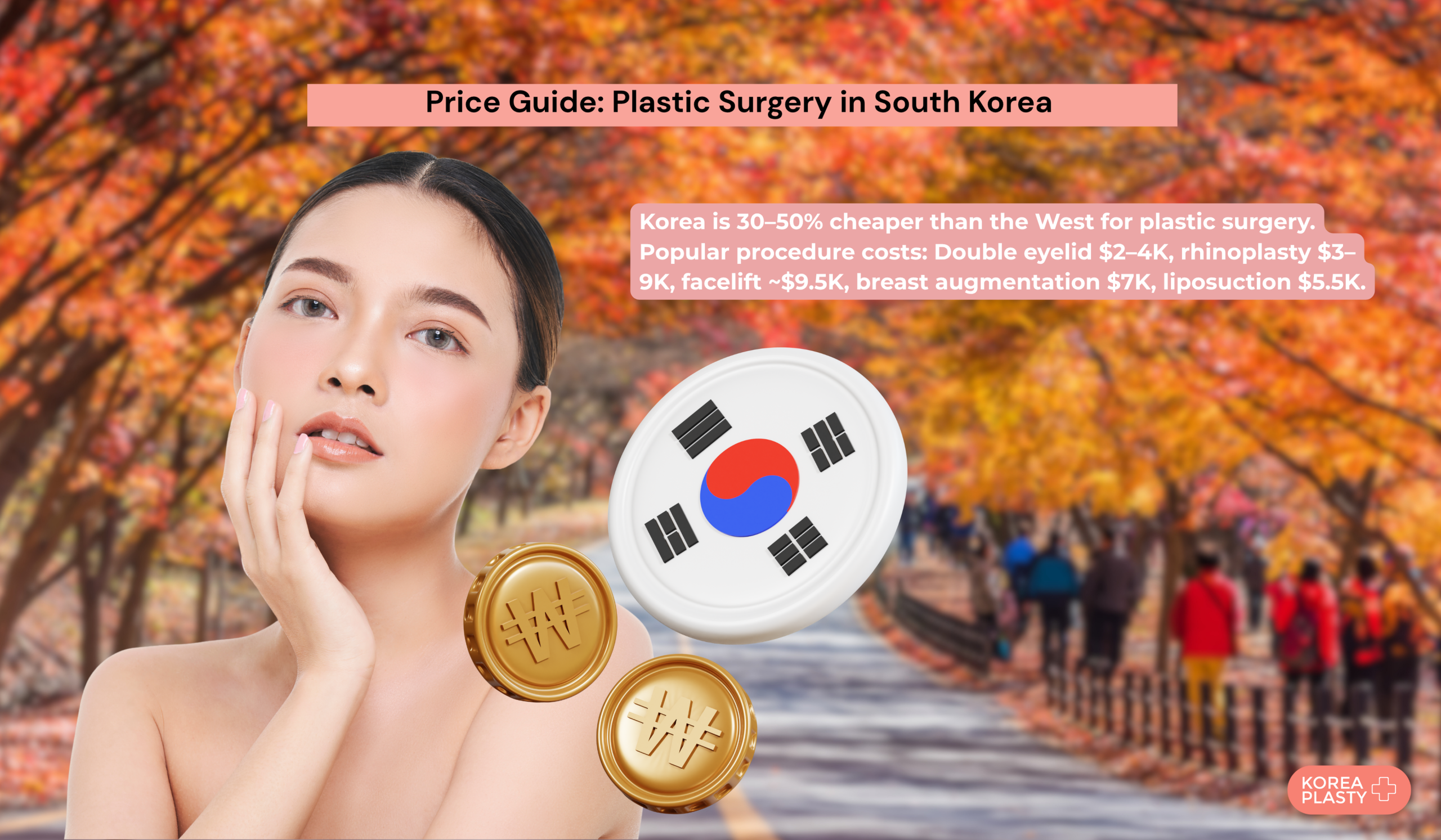
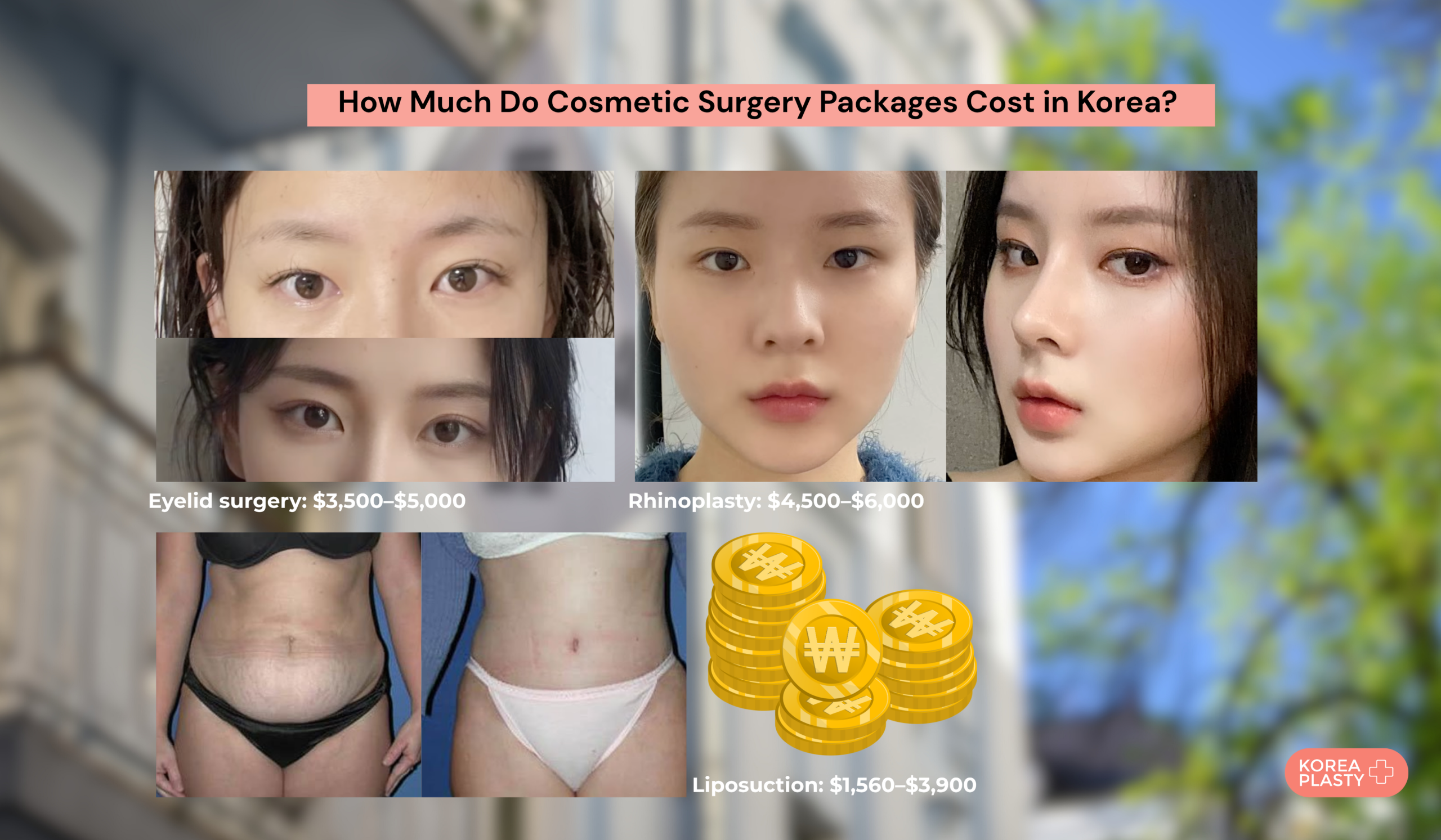
What is the cost of a plastic surgery package in Korea?
Plastic surgery packages in South Korea generally range from $3,000 to $25,000; cosmetic surgery procedures vary from around $200 for basic Botox to over $20,000 for complicated surgeries. Korean plastic surgery tour packages cost from $4,000 to $10,500 on average and bundle consultations, medical tests, surgery, anesthesia, accommodation, transfers, translation services, personalized care, and follow-ups.
Eyelid surgery packages cost $3,500-$5,000, rhinoplasty packages $4,500-$6,000, breast augmentation packages $3,500-$7,000, mini facelift packages $2,000-$6,000, full facelift packages $9,000-$13,000, V-line surgery $5,000-$10,000, liposuction $1,560-$3,900, and tummy tuck packages $13,000. Patients from Western countries save 40%-65% even after factoring travel expenses, because costs are typically 30-50% lower than in Western countries; the same procedures in the US cost $12,000-$23,000 for surgery alone.
